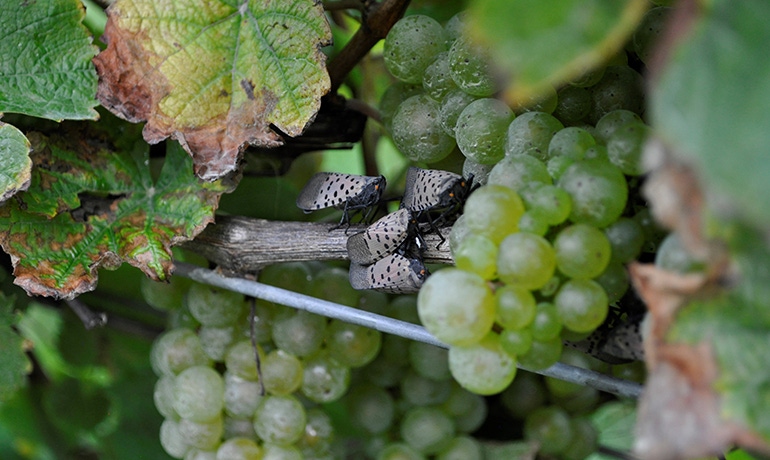
Originating from the Far East, most likely from China, the spotted lanternfly (Lycorma delicatula) is a colorful and by some standards a beautiful insect that was first discovered on U.S. soil in Pennsylvania in 2014.
But entomologists with the United States Department of Agriculture’s Animal and Plant Health Inspection Service (USDA-APHIS) warn looks can indeed be deceiving. The pest sports a voracious appetite and is known to feed on at least 40 species of native plants in the United States, including grapevines, apple and stone fruit trees, walnut, maple, and hardwood trees. Posing a threat to both commercial agriculture and U.S. forest lands.
While the spotted lanternfly (SLF) has not been spotted in California, USDA warns their remarkable reproductive ability and the speed at which they can advance make them potentially a risk for other states. They have also been confirmed in neighboring states including New Jersey and Maryland.
“Lanternflies lay massive egg sacks and are capable of overwintering under the right conditions, and they tend to feed on many types of plants including trees, row crops, nursery crops and ornamentals,” noted USDA-APHIS Spotted Lanternfly Pennsylvania Program Coordinator Leo Donovall.
Donovall says southeastern Pennsylvania is the most infested area in the United States, the area where the pest was first discovered.
“In and around Redding and Allentown (Pa.) we are seeing high populations. We have seen them in apple orchards and vineyard’s in early fall and lanternflies were flying in and out from the wood line into (row) crops where they would lay their eggs, so once they get established they can become a problem,” he said.
Since 2018, USDA has allocated over $32 million to control, contain, and suppress the impact of spotted lanternfly in Pennsylvania, Massachusetts, Maryland, New Jersey, New York, Virginia, Delaware, and North Carolina. This includes funding for survey, mitigation, treatment evaluations, monitoring tools, impact assessments, biological control, and outreach.
SLF movement in all directions
In just over four years Donovall says USDA-APHIS has watched the species migrate, generally because eggs sacks attach to vehicles and rail and truck shipping containers.
How they arrived on the U.S. coast is uncertain, but Donovall says the pest originated in China and is also prevalent in Vietnam, South Korea and other eastern points-of-origin.
“Pennsylvania is a major shipping destination for cars manufactured in Korea, for example, and we know SLF like to attach their egg sacks indiscriminately on wood, steel and concrete products,” Donovall reports.
An ongoing USDA-APHIS campaign encourages shippers, truckers, and even people moving from one state to another to look carefully for what looks like egg sacks before transport. This is the most likely method of lanternflies migrating to other locations.
He notes that almost regardless where the lanternfly eggs hatch, they are likely to find suitable forage.
“They will feed on almost any kind of vegetation, which makes them a major threat.”
The University of California, Riverside Center for Invasive Species Research has received funding to test biological control of the SLF ahead of the possible arrival of the pest in the Golden State. Dr. Mark Hoddle, Director of the Center, says the pest has not been discovered in California but research is underway to determine if a small predator wasp is safe and effective in helping to control their numbers if they should eventually arrive.
The Center received a $544,000 grant from the California Department of Food and Agriculture to conduct the study.
Entomologists say one of the biggest threats from the lanternfly is the black, sooty mold, or honeydew, that develops during intense infestations. The sticky material damages plants and trees and complicates the harvest of many commercial crops.
Best method of control
While many fungicides are effective against SLF, many of them are harmful to pollinator colonies, further complicating their use in many orchards. While biological control efforts can add to the management toolbox, the best method of keeping SLF numbers low is by promoting public and commercial campaigns to help identify and report the arrival of the pest. In Pennsylvania, for example, an aggressive campaign of public awareness and a dedicated hotline for reporting the pest and possible egg sacks has been an effective method to help establish quarantine zones to limit movement.
UCCE farm advisors encourage farmers to become familiar with the risks of SLF and learn to identify the pest and the eggs it lays and report any suspicions immediately to extension authorities.
About the Author(s)
You May Also Like






